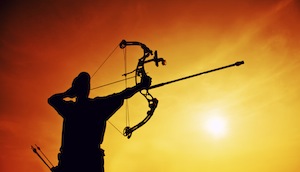Watching the Hunger Games this weekend has made me an archery enthusiast or as they call it “taxophilites.” The lead character Katniss has an amazing skill at handling the bow and arrow. Jennifer Lawrence, the actress playing Katniss, had to receive several lessons from a professional archer to prepare her for the role.

Archery
If you’ve ever tried to shoot a bow and arrow, you’ll quickly realize it is much harder than it looks. Trying to hold up the bow can be a challenge in itself, but then trying to actually aim and shoot can be impossible if you lack the proper muscle strength.
Strength in archery is not only being able to draw a bow, but being able to maintain balance and stay steady as you aim and shoot. The poundage of the bow you use is based on how strong you are. Beginners usually start off with a light draw bow. As they develop their skills and strength they will move on to a stronger draw weight bow.
Some of the best ways to develop your muscles is to use progressive loading and specific movement. Progressive loading means gradually increasing your training workload over time in response to progress. According to Paul Rogers from About.com, there are several ways to do this: Increase the weight you lift; increase the number of sets; increase the number of exercises you do in a session; increase the number of days you train.
Specific movement of the muscles being used will also help with developing your skill. The muscles groups used in archery include: the upper back and shoulder muscles to draw the bow, the puper and lower shoulder muscles to control the draw arm, and the finer muscles to hold the bowstring. To strengthen these muscles, the exercise used should closely imitate the movement of shooting a bow. Using strength bands is an example of a good way to strengthen the appropriate muscles. Also, keep in mind you need to exercise both sides of your body for muscle balance. Other muscle groups that are often over-looked in archery are include the upper and lower leg muscles to control balance, the lower back and waist muscles to control a steady stance.
